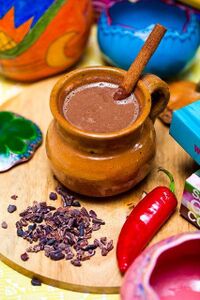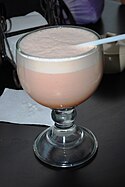Mutulese Chocolate
This article is incomplete because it is pending further input from participants, or it is a work-in-progress by one author. Please comment on this article's talk page to share your input, comments and questions. Note: To contribute to this article, you may need to seek help from the author(s) of this page. |

Chocolate, (Mutli: "Kakaw") is produced all throughout the Mutul, in quantities between 9,000 and 20,000 tons of tablets and 9 - 10 millions of bottles per year. The Divine Kingdom is the largest producer of liquid chocolate in the world, and one of the two largest exporters of cacao alongside Sante Reze. Chocolate is almost cosubstantial with the country, as traces of chocolate beverages and vessels associated to its consommation can be found even in the oldest archeological sites. It is supposed that the cultivation of the cacao tree was brought north from the Ucayare forest by nomadic populations of agro-forester. The chocolate produced range from expensive chocolates sold internationally to modest creations usually only seen within the Divine Kingdom.
Two concepts central to the better Mutuleses chocolates are the Kab'an, which links the style of the chocolate to the locations where the cacao are grown and transformed. The second is the Divine Mark (ఖుకౢ ఎతల, K'uhul Etal) that certifies the origin and the quality of the chocolate. The rules of the attribution of the Divine Mark closely define which cacao varieties and transformation practices are approved for classification in each of the Mutul's 75 000 exploitations. These rules only cover the production and distribution of liquid chocolate, chocolate tablets and "solid chocolate" do not show the same level of regulation, as they are not considered socially to be as prestigious.
History
Early days
Evidence suggest that the cacao tree was first cultivated by humans for its pods' sweet pulp. Fermented, it was served as an alcoholic beverage in the Mutul since 1400 BCE. The first real evidences of the culture of cacao are from Sante Reze, and date back to more than 5000 years ago.
Depiction of offerings of cacao to the gods or to mortal rulers during the Paol'lunyu Dynasty show that it was the kakaw drink that was used for exchanges, not yet to cocoa beans themselves.
Cocoa bean as money
Styles, varieties, and Kakawnal
Kakawnal
The Mutul possess many "Kakawnal", agricultural plantations dedicated to the cultivation of the cacao trees (Mutli: Kakaw T'e). Each has soils, practices, and an history characteristic of the parcel. It's on these specificities that the Kab'an is defined.
For the chocolate industry, the Kab'an refers to the unique combination of natural factors such as soil, underlying rock, altitude, terrain, and microclimate. It is an important factor, alongside the cultivar of chocolate, being measured in the Certification system which guarantees the origin and quality of the production.
The Divine Throne imposes the most severe restrictions on cocoa producers worldiwde. Strict regulations control many aspects of chocolate-making including planting, irrigation, classification, and labeling. It commonly resort to legal actions to protect the nomenclature created centuries ago.
Varieties
On the world stage, chocolate makers recognize three main cultivar groups of cacao beans used to make cocoa and chocolate: Forastero, Criollo and Trinitario. The most prized, rare, and expensive is the Criollo group, the historical cocoa bean of the Mutul. Worldwide, only 10% of chocolate is made from Criollo, which is arguably less bitter and more aromatic than any other bean. In the Mutul, it is up to 80%. Outlying cacao producers who aren't located in the natural biome of the cacao tree still prefer other varieties that are more resistant to diseases and weathers and have higher yields. Since the 2000s, these producers have shifted en-masse to Trinitario, an hybrid between Forastero and Criollo supposed to preserve the qualities of both.
Production
There are substantial differences in the structure of the Mutulese chocolate industry and those from elsewhere around the world. For example, it is characterized by a high level of fragmentation of the production with 400,000 chocolate producers. The top 10 brands control only 4% of the market. These structural differences are driven by institutional heterogeneity and contrasting patterns of historical development. However, they are also driven by the competitive strategies employed by Mutuleses firms, focusing on premium Fine or Flavor Cocoa rather than bulk trade.
Landowners appear to be able to exert power in particular locations where high-quality land is scarce. This appears to be a problem particularly in France, where most producers are small, and good new acreage is extremely scarce. Big investments in technology and automation have also raised the barrier of entry which historically had been quite low. Some Mutulese families continue however to produce their own chocolate for their own private consumption. However, Mutuleses markets continue to eschew advertising with chocolate products being recognized first by their type (chocolate proper, chocolate wine, chocolate liqueur, cocoa juice...) and the region of origin. Similarly, they engage in very little consumer branding, considering their clients to already be "educated" in matter of chocolate, further limiting product differentiations. All of this favour the buyer against the producer, feeding centuries-old feuds between rival chocolatiers as they compete to leave their mark in a difficult market.
Regional products
Choco
Since the time of the K'uy Dynasty, cocoa has been imported, or even adapted, to the Yajawil of Kanol becoming a staple beverage of the region. The most prestigious of these local Choco is the one from the town of Natzachan and its surrounding valley which continue to be the local chocolate capital of the Tatinak people despite most of the region' production having moved to the coastal plain. The Festival of Natzachan is notably dedicated to chocolate and its patron god : Ek Chuah.
There are many variants of Choco, each chocolatier having its own protected traditional recipe. But commonly, the ingredients are toasted maize, fermented cacao beans, and cinnamon. The ingredients are ground into a paste which is then beaten by hand and mixed with some water and sugar. It is only served cold, possibly even with some ice. It usually brown colored with a foamy surface. It has an aroma of chocolate plus a combination of the spices that compose the specific choco.
K'uhb
Nuu Davi and Ben Zaa people of the Yajawil of Muynal produce a non-alocholic chocolate-maize beverage known as Cu'uhb in Zapotec, and K'uhb or K'ujb in Mutli. Principal ingredients include toasted maize, fermented cacao beans, toasted mamey pits and cacao flower. These are finely ground into a paste. The paste is mixed with water, usually by hand, and when it is ready, the flor de cacao rises to the top to form a pasty foam. It can be served as-is or with some sugar syrup to sweeten it. The drink is served cold.
Bupu
The Ben Zaa diaspora has also spread, first to the rest of the Mutul and then to the world, another chocolate beverage closely associated with them : the Bupu. It's a sparkling non-alcolohic drink prepared from Sah, cocoa beans, and guie' chachi flowers. The latter ingredient make the preparation of the beverage especially difficult as a dosage error would make it poisonous. Otherwise, it is considered an important medecinal drink for the diaspora.
Kakaoeja
Although they are mainly common in the Yajawil of T'ichan The Winik Atel are present across the middlewest and middlesouth of the Mutul, where the S'amuy valley open on the semi-arid regions of the southeast. There, they produce a beverage known as Kakaoeja or "cacao water" made from a mixture of roasted maize, chocolate, ground pine nuts, achiote, vanilla and sugar. Ingredients do vary, and it is said that the poorer families' variants are dominated by the taste of roasted corn, while more prestigious and commercial productions are chocolate-dominant in flavour. It's a cold drink, with its ingredients stirred in cold water and often consumed with ice cubes.
In the south of the Yajawil of Yokok'ab, the Tzotzil produce a kakawa drink very closely related to the Kakaoeja of their Winik Atel cousins. But while the recipe is almost identical, an important difference is that they serve it hot: the ingredients, once grounded, are mixed with Coconut milk and heated.
Koko

In the north of the province, the Yokot'an drink a beverage known as Koko. It is typically made from toasted cacao beans, rice, cinnamon, anise seed and asquiote. The recipe is simple: The rice is left in water to soften. Any fruit added to the drink is to be finely chopped and grounded together with the rice, cinnamon, and anise seeds. The resulting dense pasta is then mixed with water and strained several times with a cotton cloth. Finally, sugar and ice are added, and it is foamed with a wooden grinder.

